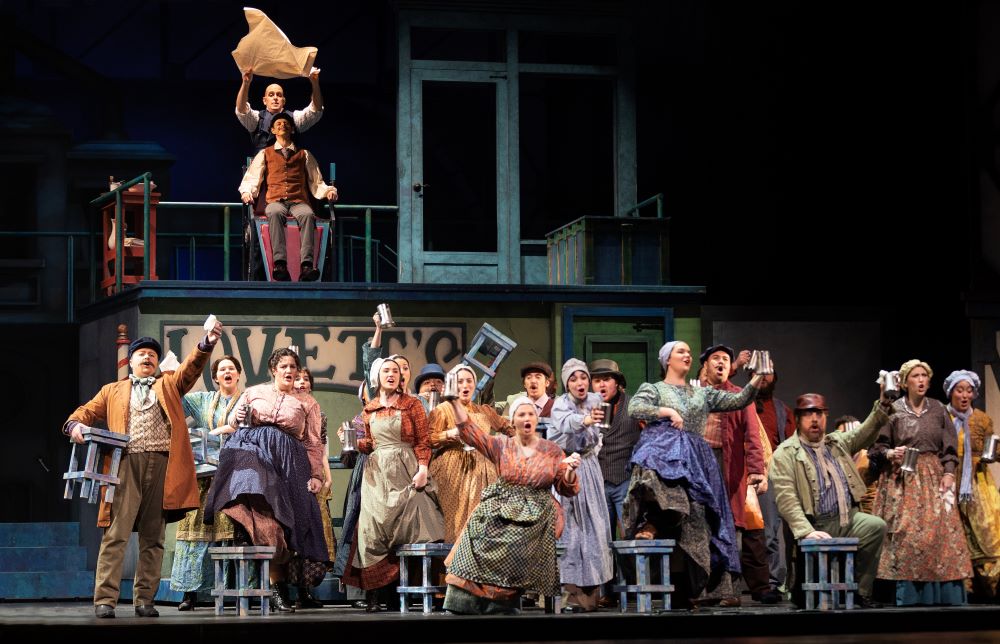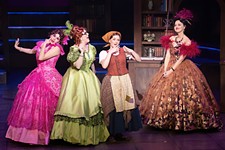Review: Austin Opera’s Sweeney Todd: The Demon Barber of Fleet Street
Sharp Sondheim staging could benefit from some musical raggedness
By Bob Abelman, 7:00AM, Wed. Feb. 1, 2023
Legendary composer/lyricist Stephen Sondheim’s Sweeney Todd: The Demon Barber of Fleet Street won the 1979 Tony Award for Best Musical. But with 85% of its dark, dramatic storyline sung, and a score requiring a tormented F2-Gb4 bass, flamboyant B2-C5 tenor, and sprightly Bb3-A5 soprano, operatic stagings seemed inevitable.
It was also only a matter of time before Austin Opera would give it a go. its first musical since opening in 1986 and, to date, its highest-grossing show. Still, genre-jumping comes at a cost.
Sweeney Todd revolves around a despondent barber (bass Kevin Burdette) out to avenge his wrongful imprisonment and the senseless destruction of his fledgling family. Living in seedy Victorian London, Todd whittles away at his clientele with a straight-edge razor as the fruits of his labor are processed into meat pies and sold in the shop below by his delightfully demented landlady, Mrs. Lovett (soprano Mela Dailey, singing alto), all the while waiting for the evil Judge Turpin (bass/baritone Ron Raines) to walk through his door. It was Turpin who set this madness in motion, and now the lecherous guardian of Todd’s daughter, Johanna (soprano Raven McMillon), and the nemesis of her beloved sailor, Anthony (baritone Mark Diamond, singing tenor), is deserving of the closest shave he’s ever had.
It has become fashionable and cost-efficient of late for mountings of Sweeney Todd, like the one at The University of Texas’ Butler Opera Center in 2014, to fly in the face of a traditional, full-scale performance by serving up minimalistic production values with a downsized dramatis personae. Other offerings, such as the 2004 Broadway revival, have on-stage actors accompanying themselves on musical instruments in lieu of a sizable pit orchestra. Not so in this production under director Doug Scholz-Carlson’s steerage, where “go big or go home” drives the size and quality of music director Timothy Myers and chorus master Cina Cresara’s assets, complemented by James Sale’s intense lighting design, Melanie Steele’s period make-up and wig work, and sets/costumes loaned from Des Moines Metro Opera under R. Keith Brumley and Johnathan Knipscher’s supervision.
The stage is brimming with multistory pieces and parts that rotate and roam with ease, purpose, and dramatic effect. And because the musical has now transitioned into the realm of opera, that performance space is also filled with classically trained artists with powerful head voices and, it seems, genetically engineered diaphragms.
Bob Fosse once said that “the time to sing [onstage] is when your emotional level is too high to just speak anymore.” In opera, there’s the additional need to sing in heightened expression with raised volume per the traditional tropes and techniques that guide the art form. The featured players in Sweeney Todd do this brilliantly and masterfully manage Sondheim’s dense and difficult lyrics, demanding vocal range, and enigmatic melodies. With the exception of ensemble member solos, which can hardly be heard, Sweeney Todd’s lyrics rattle off the rafters.
(The quotable Fosse also said that, in musical theatre, “the time to dance is when your emotions are just too strong to only sing about how you feel.” There are no dance breaks in Sweeney Todd, which may be a major reason why the show was selected and is making the rounds among opera companies like ours. It might also account for at least some of the record ticket sales.)
But much of the sweet subtlety and emotive phrasing woven into Johanna’s lyrical “Green Finch and Linnet Bird” and Anthony’s delicate love song “Johanna” get lost in McMillon’s gorgeous but overwhelming soprano and Diamond’s beautiful but excessively generous tenor. Similarly, Mrs. Lovett’s assistant Tobias Ragg’s youth and intellectual disabilities are betrayed by Christan Sanders’ physical maturity and powerful projection. Dailey’s Mrs. Lovett, too, sacrifices some of her character-defining macabre charm and humor at the hands of her well-honed classical technique and tone.
Still, there is much gained by a Sweeney Todd gone operatic. Bille Bruley’s powerful vocals and fine acting provide his Beadle Bamford with a scene-stealing moment at the harmonium, and Angel Romero as Pirelli, the singing barber, is terrific. Best of all is when Burdette allows an intriguing dose of melancholy to seep through the otherwise dark and forbidding vibrato he has gifted Todd.
Austin Opera’s Sweeney Todd: The Demon Barber of Fleet Street
The Long Center for the Performing Arts, 701 W. Riverside, 512/472-5992
austinopera.org
Through Feb. 5
Running time: 2 hrs., 40 min.
A note to readers: Bold and uncensored, The Austin Chronicle has been Austin’s independent news source for over 40 years, expressing the community’s political and environmental concerns and supporting its active cultural scene. Now more than ever, we need your support to continue supplying Austin with independent, free press. If real news is important to you, please consider making a donation of $5, $10 or whatever you can afford, to help keep our journalism on stands.
Dec. 15, 2023
Austin Opera: Sweeney Todd: The Demon Barber of Fleet Street









